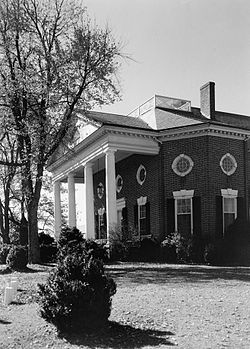Farmington (Albemarle County, Virginia)
Farmington | |
 Farmington, HABS Photo | |
Location in Virginia | |
| Location | West of the junction of US 250 and US 29, Charlottesville, Virginia |
|---|---|
| Coordinates | 38°03′44.27″N 78°32′30.10″W / 38.0622972°N 78.5416944°W |
| Area | 10 acres (4.0 ha) |
| Built | 1780 |
| Architect | Thomas Jefferson |
| Architectural style | Early Republic, Jeffersonian |
| NRHP reference No. | 70000782[1] |
| VLR No. | 002-0035 |
| Significant dates | |
| Added to NRHP | September 15, 1970 |
| Designated VLR | July 7, 1970[2] |
Farmington is a house near Charlottesville, in Albemarle County, Virginia, that was greatly expanded by a design by Thomas Jefferson that Jefferson executed while he was President of the United States. The original house was built in the mid-18th century for Francis Jerdone on a 1,753-acre (709 ha) property. Jerdone sold the land and house to George Divers, a friend of Jefferson, in 1785. In 1802, Divers asked Jefferson to design an expansion of the house. The house, since greatly enlarged, is now a clubhouse.
Description
The Jefferson addition comprises the present building's main facade, consisting of an elongated octagon with its long axis perpendicular to the large
Influence
Farmington was extensively studied by University of Virginia architectural historian Fiske Kimball, who adapted the design for his own residence, Shack Mountain, now a National Historic Landmark.[5]
Farmington was placed on the National Register of Historic Places on September 15, 1970.[1]
References
- ^ a b "National Register Information System". National Register of Historic Places. National Park Service. July 9, 2010.
- ^ "Virginia Landmarks Register". Virginia Department of Historic Resources. Archived from the original on 2013-09-21. Retrieved 2013-05-12.
- ^ Virginia Historic Landmarks Commission Staff (May 13, 1970). "National Register of Historic Places Inventory - Nomination Form: Farmington" (PDF). National Park Service. Retrieved 21 October 2011.
- ISBN 0-19-515206-9.
- ^ Virginia Historic Landmarks Commission Staff (June 1976). "National Register of Historic Places Inventory - Nomination Form: Shack Mountain" (PDF). National Park Service. Archived from the original (PDF) on 9 June 2012. Retrieved 21 October 2011.
External links
- Farmington, U.S. Route 250 vicinity, Charlottesville vicinity, Albemarle, VA at the Historic American Buildings Survey(HABS)




